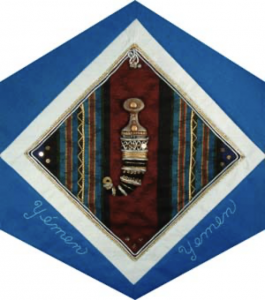Yemen

The Block
Yemen still preserves many traditional practices that reflect its rich cultural history and Yemenis have become masters at creating items from ages past. One such object is the jambiya, a dagger and gracefully-curved dagger-sheath that is acquired by males upon reaching manhood. Its name is believed to derive from the word janb (next to) since the piece is worn at the front of a man’s body and accompanies him wherever he goes. A miniature version, resting on a background of hand-woven fabric is featured on this block, by Heyam Qirbi. Its wood handle, carved by Elspeth Greer, slides into an al-aseeb (sheath) that is embellished with the metallic embroidery for which Yemen is renowned.
Metallic embroidery also borders the piece and is symbolic of scabbards that are often heavily filigreed in silver or gold. Jambiyas, which are held in place by brightly coloured and intricately patterned belts, were once used as weapons for self-defense. Today they are worn for more decorative purposes, such as in traditional ceremonies and as indicators of status.
Cultural Profile
Yemen, situated on the southwest corner of the Arabian Peninsula in southwest Asia, was well-known historically as ‘Arabia Felix’ or the ‘Land of the Two Paradises.’ It is the reputed home of the famous Queen of Sheba and has the world’s oldest university at Zabid, a famous learning centre with over 200 colleges, where it is speculated that algebra originated. One of the oldest Qu’ran manuscript was found in Sana’a, dating back to 671. The ancient city of Marib, one of the most famous areas in Yemen, is known for the Marib Dam, which is over 2,000 years old, and for irrigation canals that suggest Yemenis were the pioneers of irrigation. The main ethnic group is Arab, with Afro-Arabs, South Asians and Europeans comprising the remainder of the population. The official language is Arabic, which nearly all Yemenis speak, albeit with dialectical differences between regions.
Western Yemen receives the highest rainfalls in Arabia. The irrigation systems which distribute the rain allow this part of the country to be used for agriculture, with sorghum, cotton, fruit trees and qat being important crops. The eastern part is mostly desert inhabited by nomadic Bedouins raising livestock.
Yemen’s culture include the al-Ghina al-Sanani, the Song of Sana’a. These songs are played at weddings and during qat sessions. The traditional lyrics are accompanied by Yemeni lute and the sahn nuhasi, a copper tray that serves as a percussion instrument. There is a diverse tradition of arts and handicrafts. Stained glass, often used to decorate public buildings and private homes, is a popular art form, as are painting, sculpture and metalwork. The country is also known for its silver, brass and copperware, and leather goods.
Textiles, woven into skullcaps and robes, are traditionally woven using ground looms sometimes so wide that two weavers are needed to make the cloth. Indigo is a popular natural dye used in clothing in the country. Traditionally, women wore very colourful clothes, not unlike the colourful garments worn by Ethiopian and Somalian women across the Red Sea. However, the abaya, the long, black robe favoured in the Arabian Peninsula, is becoming more popular, especially in city centers. The men almost always wear the aba’a, a long robe white, striped or checkered that often features embroidery.
Yemen’s unique domestic architecture includes elaborately decorated, multi-storey, towered houses. Made from stone, brick or mud, they are often perched on mountainsides. The bottom floor of the home is for animals, the next floor, or diwan, is a reception room for guests, the next few levels are bedrooms and a kitchen, and the top floor is the mafraj, where the most distinctive and important Yemeni social institution––the qat session––is held. The qat session is an afternoon gathering at which men and women meet separately to chew the leaves of the qat plant and discuss various issues.
People have been coming to Canada from Yemen since the early 1900s, with the main groups arriving between 1961 and 1975. Many early immigrants settled in Québec, Ontario, Alberta and British Columbia, and became factory workers and labourers. The Yemeni population in Canada remains small, and organizations such as the Yemeni Canadian Media and Cultural Centre in Ottawa work to bring Yemenis together, as well as to promote their culture within Canadian society. As of 2011, there were nearly 4,000 Yemenis living in Canada.
Sponsor: Wes and Carole Libbey
